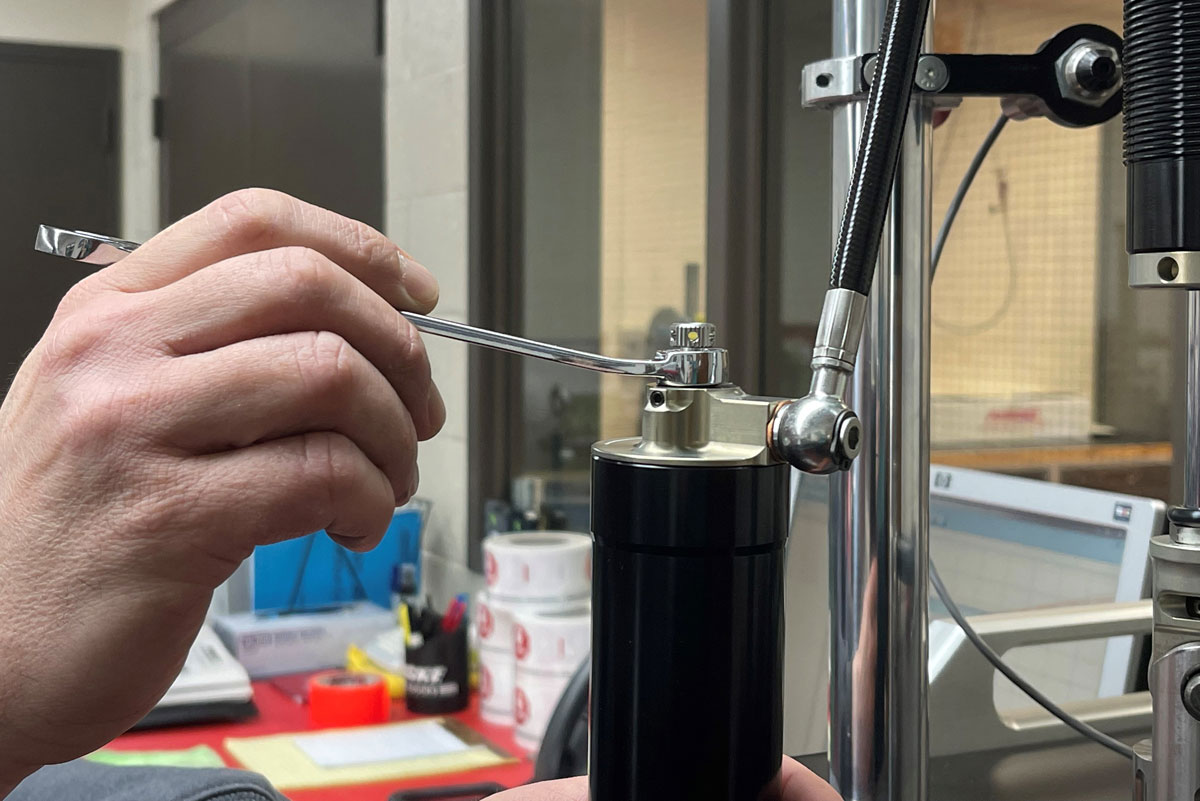How to Properly Use a Penske Shock Tuning Guide to Optimize Your Performance

January 31, 2022

Most people can change a lightbulb. But a light fixture? That requires research and expert help.
In all areas of life, there are tasks that you can master yourself, but there are others that benefit from a collaborative process. Unless you decide to become an expert, simply following a shock tuning guide isn’t going to bring the same results as working with a team of people who have the knowledge but also first-hand experience and success in optimizing race car suspensions.
In this article, we’ll explore basic shock tuning and the results you can expect, as well as what to expect if you invest in proper shocks with the correct setup and support.
Using a Penske Shock Tuning Guide to Optimize Your Performance
We do have a Penske shock tuning guide, but to be frank, there isn’t a definitive guide to shock tuning. There are so many variables at play, and driver feel is paramount, so it would be dishonest of us to provide a be-all and end-all guide to tuning your shocks.
What we can do is provide knowledge and expertise to show you what you should be looking out for when you purchase, install, and adjust your shocks to suit your driving or riding preferences.
The goal of suspension tuning as a whole is to improve how your car handles. Shocks play a significant role in how your tires maintain contact with the road or track in any situation, so let’s nail the basics first.
What Do You Need To Know?
The right components of a suspension include the tires, tire pressure, springs, roll or sway bar, and shocks. The whole package must be optimized to maintain traction in any race condition. The manufacturer you decide to purchase your shock from should play an active role in optimizing parts for your setup.
Once you have the right components, you need the right tools to test and retest. You will need to test to answer: What works? What doesn’t? What do you need to adjust? The right driver feel, or more precisely, how your car handles on the road or track is paramount and the goal of your testing.
Check out our FREE DOWNLOAD: Shock Build and Shock Setup/Lap Time Worksheet
In this free download, we provide both our Standard Shock Build Sheet, which is a great way to keep all your shock builds organized, and a Setup/Lap Time Sheet, a great tool to help improve your communication and record keeping of your chassis setup.
To truly optimize your shocks, your overall suspension setup must be right, including ride height, camber, caster, toe, and the correct spring rates. Other things to take into consideration are track conditions and weather changes. We delve deeper into race suspension tuning basics here.
Not All Shocks are Made Equal
A great shock should be precise, resistant to fatigue, and durable. We are an industry leader on the cutting edge of damping innovation and design. The people that design and fit your shocks have experience at the race track, in the shop, and solving problems.
Our Penske shocks are high quality, American-made, and can be used for many applications. All Penske shocks are hand-built specifically for each individual application, and they can also be adapted to fit a wide range of requirements such as changes in class or chassis changes, giving you high-quality shocks for a fair price.
The Basics of Shock Tuning
All shock tuning guides should tell you one thing: The primary job of shocks is to control how slowly or quickly your wheels move up and down.
By stopping your springs from compressing or rebounding too quickly, shocks play a pivotal role in your driving experience.
- Stiffer shock rates slow spring movements enough that your suspension doesn’t bottom out but not so much that your tires bounce off the road surface over bumps. But, when your shocks are too stiff, your car might feel unpredictable.
- Softer shock rates allow the springs to move faster, improving compliance and traction, but if they’re too soft, your car might bounce after hitting bumps or ruts.
How can you tune your shocks to find a balance between stiff and soft with the above in mind?
Extra Tip: Shocks work together with the springs.
Without shocks, springs would store energy when compressed and release energy when they rebound without control, and your car would just bounce up and down.
The springs themselves support your car’s weight and absorb or damp the shocks experienced from road friction, and ensure the wheels track the road’s surface as it changes.
Shocks dissipate the stored energy and control the speed at which your springs move up and down by stopping them from compressing or rebounding too quickly.
Adjusting both will bring the best results.
Low-speed Damping
Most drivers like adjusting low-speed damping. Increasing low-speed damping seems to give the driver quicker and better feedback from the chassis, leading to higher confidence in the car. The chassis won’t move around as much with increased low-speed damping.
Too much low-speed damping can decrease grip during changes of direction, limit power in slower corners, and lack overall grip after initial turn-in. Too much low-speed damping can also give the sensation of the vehicle being "on top" of the track, not allowing the tire to "dig" into or "bite" into the track, which can result in a lack of overall grip after initial turn-in or a lack of forward bite during throttle application. You can see why low-speed damping is essential to tune and get just right, especially to optimize performance.
Want to learn more? Check out What is the Difference Between Low-Speed Damping and High-Speed Damping?
High-speed Damping
High-speed damping is more for curb strikes or other high-velocity high displacement hits.
Typically, this is more for driver comfort, which, when it comes to setup, is secondary to overall lap time. But in cases where large bumps or curbs may be upsetting the optimum driving line, you will have to tune your high-speed damping.
Not all Drivers are the Same
While the above are basic recommendations, the manufacturer you purchase your shocks from should get to know you as a driver and make recommendations based on your style and preferences.
It can be tempting to buy cheaper shocks, but lower costs often mean factory settings and decreased performance. Factory settings don’t consider your application and driving style.
Bolt-on performance is generally a myth, and it’s much better to optimize your shocks from the beginning of the purchasing process.
Why Expert Support is So Important
Shocks aren’t black magic. An excellent shock company supports you as you learn how shocks work (turning knobs, exploring what different piston types can do, implementing a proper maintenance schedule, and checking on the dyno).
It’s essential to explore the sensitivities of shock adjustments and how they translate to on-track performance and driver confidence. You should feel comfortable asking questions and getting recommendations, leaning on your supplier’s experience.
The Penske S3 Process
Forget about a be-all and end-all shock tuning guide. Shock performance is a personal process, and without the proper setup, you won’t perform optimally.
Before buying anything, work with Penske to optimize the process. We can help you to customize hardware selection for your application. Our team has the knowledge, experience, and a track record of delivering results. We work with drivers at every level of racing and activate the same performance optimization process for all of our customers.
Most importantly, we teach you to help yourself, and that’s transformational!
FREE DOWNLOAD - Damper Tuning Guide (Starter) - Ensuring a well-tuned damper setup can translate to significant performance gains on track. If you are unsure of where to begin the tuning process, this is a great starting point. Maximize the results of your shock adjustments with our free damper tuning guide download.

%20(1).png)
